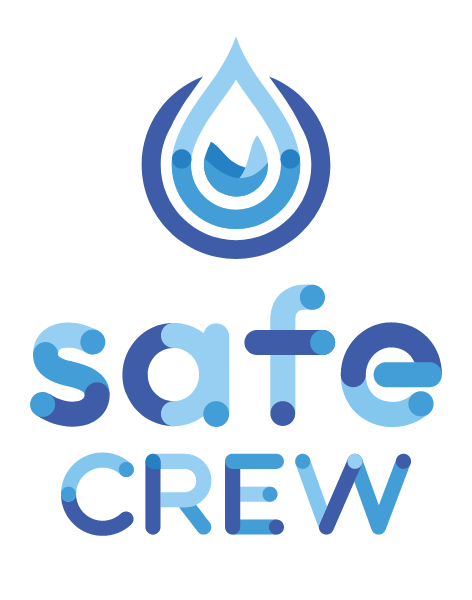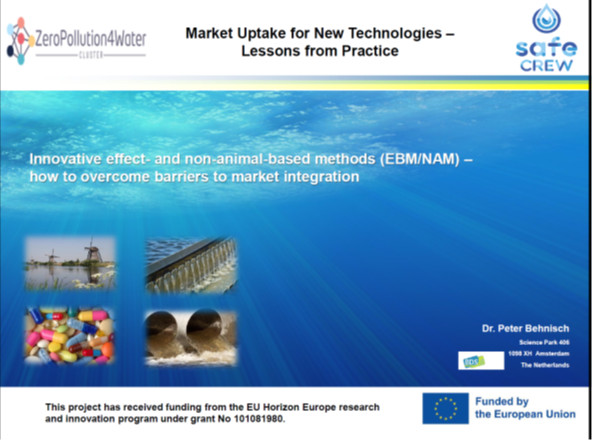Under the motto ‘Explore pathways towards bringing water innovations into the real world’ SafeCREW partner Dr Peter A. Behnisch talked on 11th November at the ZeroPollution4Water Cluster webinar “𝗠𝗮𝗿𝗸𝗲𝘁 𝗨𝗽𝘁𝗮𝗸𝗲 𝗳𝗼𝗿 𝗡𝗲𝘄 𝗧𝗲𝗰𝗵𝗻𝗼𝗹𝗼𝗴𝗶𝗲𝘀 – 𝗟𝗲𝘀𝘀𝗼𝗻𝘀 𝗳𝗿𝗼𝗺 𝗣𝗿𝗮𝗰𝘁𝗶𝗰𝗲”. He presented the strategies of his company Biodetection Systems to establish bioassays for toxicity assessment of real water samples in the market. In SafeCREW, the bioassays were applied to the testing of DBP toxicity for the first time. Additionally, the session featured a keynote speech from Evgeny Bulatov, further enriching the discourse on water innovations.
The ZeroPollution4Water Cluster webinar provided insights how to achieve market uptake for new technologies in the water sector. Evgeny Bulatov, founder of AWA Monitoring, and Peter Behnisch, CEO of Biodetection Systems shared their practical experience with bringing monitoring tools to the market.
Both speakers focussed on innovative technologies to assess the pollution of water by an ever increasing amount of chemicals. More than 140000 chemcials are currently on the market, 30000 of these are relevant for water. Knowledge about these chemicals is needed to ensure safe drinking water supply as well as freshwater life.
Evgeny Bulatov started the session with his presentation on a Ceramic Passive Sampler (CPS) and the foundation of the spin-off AWA monitoring. The Ceramic Passive Sampler was developed in the UPwater project. The Ceramic Passive Sampler is a compact cylindrical device, which is placed in water for one month. This device samples a wide spectrum of chemical contaminants which can then be analysed in an analytical laboratory for analysis. Evegeny Bulatov showed the pathway from the first idea for the solution via R&I collaboration in UPwater towards the planned roll-out in the market in 2026. He focused on the role of technology transfer and the need to switch from a technology development perspective to a user’s perspective. He put the value proposition into the centre of the considerations and suggested the KTH Innovation Readiness ModelTM as a valuable tool to ask the right questions. Finally, he showed the progress of the technology in terms of increased readiness levels regarding technology, business model and IPR as well as the team, the funding and the customer.
Peter Behnisch continued with his approach on overcoming the barriers to market integration for innovative effect- and non-animal based methods (EBM/NAM). The effect- and non-animal based bioassays CALUX(R) allow the toxicity assessment of combinations of chemicals in complex real water samples, thus focussing on the overall impact of pollutants on ecosytems and organisms in water. This addresses the challenge of the evaluation of thousands of known and unknown emerging contaminants in water and provides a high-through-put method which is cheaper, faster and easier than the testing of single chemicals. In the SafeCREW project, the bioassays are tested to assess the impact of DBPs in different waters and in contact with plastic materials. However, the pathway to market is long and can only be managed with a thorough and persistent strategy. This strategy needs to include efforts to promote regulatory action and to spot the opportunities. Regulation frameworks develop slowly, but just recently the provisional deal between the European Council and Parliament to update priority substances in surface and groundwaters introduced the EBM approach to assess water quality focussing on the overall impact of pollutants on ecosytems and organisms in water, specifically estrogenic substances. R&I cooperation with international leaders, publicly funded projects to enhance the number of showcases and application areas as well as issuing policy briefs and technical reports and contributing to standardisation form the backbone of Biodetection Systems’ strategy for market uptake. This is complemented with intense considerations of market trends, SWOT and stakeholder analyses.
Technology Transfer and Uptake: From Scientific Discovery to Commercial Product (Evgeny Bulatov)
Innovative effect- and non-animal-based methods (EBM/NAM) – how to overcome barriers to market integration (Peter Behnisch)

